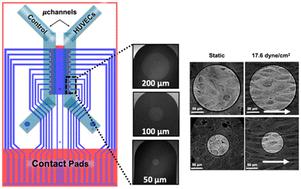Our official English website, www.x-mol.net, welcomes your
feedback! (Note: you will need to create a separate account there.)
A microfluidic impedance platform for real-time, in vitro characterization of endothelial cells undergoing fluid shear stress
Lab on a Chip ( IF 6.1 ) Pub Date : 2022-11-09 , DOI: 10.1039/d2lc00555g Vanessa Velasco 1 , Patricia Soucy 2 , Robert Keynton 3 , Stuart J Williams 4
Lab on a Chip ( IF 6.1 ) Pub Date : 2022-11-09 , DOI: 10.1039/d2lc00555g Vanessa Velasco 1 , Patricia Soucy 2 , Robert Keynton 3 , Stuart J Williams 4
Affiliation

|
We introduce a microfluidic impedance platform to electrically monitor in real-time, endothelium monolayers undergoing fluid shear stress. Our platform incorporates sensing electrodes (SEs) that measure cell behavior and cell-free control electrodes that measure cell culture media resistance simultaneously but independently from SEs. We evaluated three different cellular subpopulations sizes through 50, 100, and 200 μm diameter SEs. We tested their utility in measuring the response of human umbilical vein endothelial cells (HUVECs) at static, constant (17.6 dyne per cm2), and stepped (23.7–35–58.1 dyne per cm2) shear stress conditions. For 14 hours, we collected the impedance spectra (100 Hz–1 MHz) of sheared cells. Using equivalent circuit models, we extracted monolayer permeability (RTER), cell membrane capacitance, and cell culture media resistance. Platform evaluation concluded that: (1) 50 μm SEs (∼2 cells) suffered interfacial capacitance and reduced cell measurement sensitivity, (2) 100 μm SEs (∼6 cells) was limited to measuring cell behavior only and cannot measure cell culture media resistance, and (3) 200 μm SEs (∼20 cells) detected cell behavior with accurate prediction of cell culture media resistance. Platform-based shear stress studies indicated a shear magnitude dependent increase in RTER at the onset of acute flow. Consecutive stepped shear conditions did not alter RTER in the same magnitude after shear has been applied. Finally, endpoint staining of VE-cadherin on the actual SEs and endpoint RTER measurements were greater for 23.7–35–58.1 dyne per cm2 than 17.6 dyne per cm2 shear conditions.
中文翻译:

一种微流体阻抗平台,用于实时、体外表征承受流体剪切应力的内皮细胞
我们引入了一个微流体阻抗平台来实时电监测承受流体剪切应力的内皮单层。我们的平台结合了测量细胞行为的传感电极 (SE) 和同时但独立于 SE 测量细胞培养基电阻的无细胞控制电极。我们通过 50、100 和 200 μm 直径的 SE 评估了三种不同的细胞亚群大小。我们测试了它们在测量人脐静脉内皮细胞 (HUVEC) 在静态、恒定(17.6 达因/cm 2)和步进(23.7–35–58.1 达因/cm 2) 剪应力条件。在 14 小时内,我们收集了剪切细胞的阻抗谱 (100 Hz–1 MHz)。使用等效电路模型,我们提取了单层渗透性 ( R TER )、细胞膜电容和细胞培养基电阻。平台评估得出的结论是:(1) 50 μm SE(~2 个细胞)会产生界面电容并降低细胞测量灵敏度,(2) 100 μm SE(~6 个细胞)仅限于测量细胞行为,无法测量细胞培养基电阻和 (3) 200 μm SE(~20 个细胞)检测细胞行为并准确预测细胞培养基抗性。基于平台的剪切应力研究表明R TER的剪切幅度依赖性增加在急性血流开始时。在施加剪切后,连续的阶梯剪切条件不会以相同的幅度改变R TER。最后,VE-钙粘蛋白在实际 SE 上的端点染色和端点R TER测量值在 23.7–35–58.1 达因/cm 2大于 17.6 达因/cm 2剪切条件下更高。
更新日期:2022-11-09
中文翻译:

一种微流体阻抗平台,用于实时、体外表征承受流体剪切应力的内皮细胞
我们引入了一个微流体阻抗平台来实时电监测承受流体剪切应力的内皮单层。我们的平台结合了测量细胞行为的传感电极 (SE) 和同时但独立于 SE 测量细胞培养基电阻的无细胞控制电极。我们通过 50、100 和 200 μm 直径的 SE 评估了三种不同的细胞亚群大小。我们测试了它们在测量人脐静脉内皮细胞 (HUVEC) 在静态、恒定(17.6 达因/cm 2)和步进(23.7–35–58.1 达因/cm 2) 剪应力条件。在 14 小时内,我们收集了剪切细胞的阻抗谱 (100 Hz–1 MHz)。使用等效电路模型,我们提取了单层渗透性 ( R TER )、细胞膜电容和细胞培养基电阻。平台评估得出的结论是:(1) 50 μm SE(~2 个细胞)会产生界面电容并降低细胞测量灵敏度,(2) 100 μm SE(~6 个细胞)仅限于测量细胞行为,无法测量细胞培养基电阻和 (3) 200 μm SE(~20 个细胞)检测细胞行为并准确预测细胞培养基抗性。基于平台的剪切应力研究表明R TER的剪切幅度依赖性增加在急性血流开始时。在施加剪切后,连续的阶梯剪切条件不会以相同的幅度改变R TER。最后,VE-钙粘蛋白在实际 SE 上的端点染色和端点R TER测量值在 23.7–35–58.1 达因/cm 2大于 17.6 达因/cm 2剪切条件下更高。











































 京公网安备 11010802027423号
京公网安备 11010802027423号